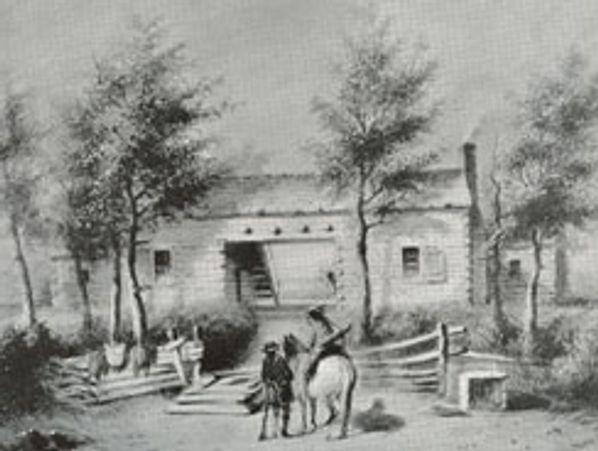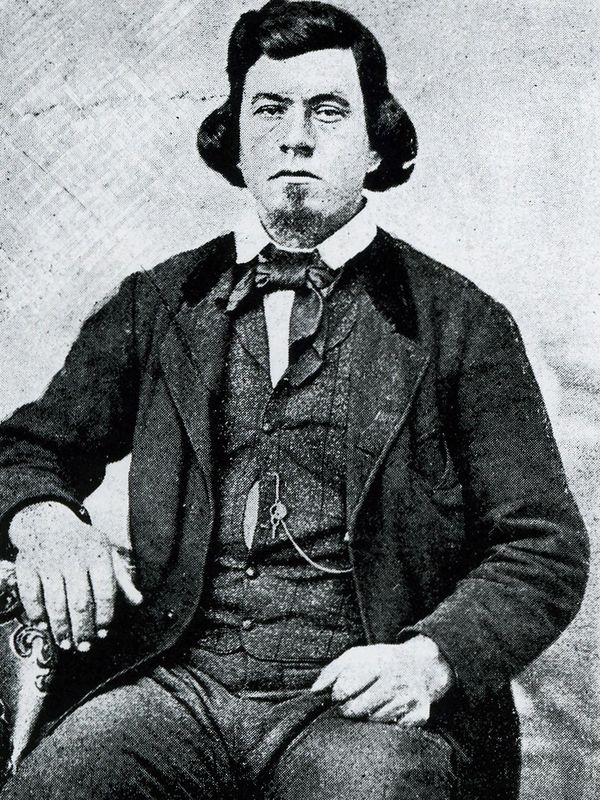The History of Eudora, Kansas
The History of Eudora, Kansas

Artistic rendering of Bluejacket inn by Bluejacket Ford.
To right, Charles Bluejacket, a mixed-blood Shawnee and owner of the inn. Bluejacket came to what would be the state of Kansas in 1832 and became a Methodist minister in 1859.

Site Content
Along the Western trails
Oregon Trail and Bluejacket Ford. Starting in Independence, Missouri, the Oregon Trail entered Douglas County in Section 27, Township 13, Range 21. At Hesper, the trail took a northwesterly direction, across the Wakarusa River. Starting in Westport, Missouri, the California Road, a section of the Oregon Trail, followed the Santa Fe Trail to near Gardner, then veered north to Douglas County, passing through Franklin and Lawrence.
Travelers crossed the Wakarusa River on the Oregon Trail and did so at three sites, according to analysis by local historian Mary Gage. The main or western crossing is in the northwest ¼ of the northeast ¼ of Section 14 was owned by Charles and Eliza Bluejacket before 1860. Trail expert Gregory Franzwa, author of The Oregon Trail Revisited, also thought this western-most crossing was the main ford.
Early emigrant diaries did not mention Bluejacket Ford because the Bluejacket name did not become associated with the crossing until 1854 when the U.S. government gave the three Shawnee Bluejacket brothers—Henry, George, and Charles, land surrounding the crossing.
Charles Bluejacket owned a short-lived inn at this crossing. William Hutter wrote a letter in 1854, saying: “Bluejacket lives at the crossing of the Wakarusa, and has two houses — one double and one single.” The 12’ house roofs, Hutter wrote, met over a breezeway.
At this point ― south of the present Highway 10 to the west of the Wakarusa bridge on E. 1900 Road, or directly north of a private barn at 1723 E. 1900 Road ― cliffs line the Wakarusa’s southern side. Cliff erosion bedded the river bottom with rock making the waterway easier to cross.
Also pointing to this site as the main crossing is a report by William Phillips, a New York Tribune correspondent, who wrote of pre-statehood military forces camping by a ford on the Wakarusa: “The Missourians had moved their camp down into the timber of the Wakarusa, and pitched it a quarter of a mile below the ford on the California road.”
The November 16, 1897 Eudora newspaper wrote: “[Charles] BLUE JACKET lived four miles up Wakarusa creek and left there over thirty years ago. He was a half breed Indian and established what was then known as ‘Blue Jacket’s crossing.’ In early history this was the only crossing on this creek for twenty miles away, and there he lived during early Kansas troubles and kept a kind of hotel for free state men as well as Mrs. STEVENS.”
The land title of Karl Gregor [Charles] Bundschu, too, points to this location. Bundschu, a German, owned land adjacent to Section 14, Township 13, Range 20 of Charles and Eliza Bluejacket. Grandson Henry Bundschu wrote in 1962 of Karl’s move to Kansas: “He bought 20 acres of land on the Bluejacket ford of the Wakarusa, near the town of Eudora. He built an Indian trading store there, inside a compound with big gates that were locked at night. Two big dogs were then turned loose to keep prowlers and Indians away. The Indians could not count. The government paid them in dimes. They knew that by placing a dime on each of their fingers and thumbs, they would have a dollar.”
Besides Bundschu, William “Dutch Bill” Greiffenstein with Joe Boinett, kept a trading store from 1852 to 1854 on the Wakarusa southwest of Eudora close to the inn, store, and ferry later opened by the Bluejacket brothers.
Gage, in an August 2000 presentation to the Oregon-California Trails Association, said: “There were two other crossings downstream, or further east: the middle crossing approximately one mile and the eastern crossing one and a half miles, that also were used by emigrants as fords across the Wakarusa River. The middle crossing is between Spring Creek and the Little Wakarusa at the location of the now extinct settlement of Sebastian.”
Bluejacket's Ford, as shown on an early map of Douglas County, was located on the southeast 1/4 of the southwest1/4 Section 12, Township 13, Range 21 east at the north boundary of Sebastian. Ron Becher in his 1990 Overland Journal article said the Sebastian site [Highway 1057 and N. 1275 Road, east for ½ mile to north of hill top] was the main crossing as did Irene Paden in her 1943 The Wake of the Prairie Schooner.
Eudora’s 1976 history concluded: “The first crossing was where the streams joined [Little Wakarusa and the main Wakarusa in the northwest 1/4 of the northeast ¼ of Section 13 Township 13 south] and the second was about a quarter of a mile north of this (or 290 yds. south of the new #10 Highway Bridge) at the north end of a sandstone ledge.”
Becher says this site was actually between the mouths of Spring Creek and the Little Wakarusa with a steep, curing ramp approach and a ford over a bed of solid limestone. The lower crossing, he said was 800 yards northeast and 220 yards south of the Highway 10 bridge in the northeast ¼ of the southeast ¼ of Section 12. Eroding sandstone cliffs were said to have held the carvings of names and initials.
About Gage’s site, Becher wrote: “This ford is superior to either of the two lower fords with regard to ease of crossing and would have furnished a direct link between the northern and southern branches of the Oregon Trail, the distance between being slightly more than one mile.”
The Lawrence Herald of Freedom May 26, 1855 death notice of Henry Bluejacket wrote “Shawnee Indian chief” Bluejacket died “at the lower crossing of the Wakarusa,” upholding the idea of additional Wakarusa crossings. One of these crossings, presumably the main one, had a ferry to carry travelers. Although the Wakarusa River can be waded across, at times, its waters do rise out of the banks during times of excessive rain.
George Root in his 1937 “Ferries in Kansas” article using information from C. P. Deathrage’s "Kansas River Steamboats," Early History of Greater Kansas City, Missouri and Kansas, Vol. 1, (1927), wrote: “The first and probably the only ferry over the Wakarusa was at Bluejacket's, where the Oregon Trail from Westport crossed this stream. Just when Bluejacket inaugurated this service has not been definitely learned, but it must have been early in 1855, when the bulk of travel south of the Kansas River followed the Oregon trail.
“The flatboat for Bluejacket's ferry was built in 1855 by a Shawnee named Tula or Tooley, who operated a ferry not far from the Delaware crossing, or Grinter's as it was commonly known. The Emma Harmon, a small stern-wheeler, and the first steamboat to ascend the Kansas river after the white settlement began, had left Kansas City on the afternoon of May 19, 1855, for Topeka and way landings. About noon the next day the boat went to the bank to get a supply of wood, and shortly after starting again it was hailed by an Indian, who made the crew understand that he wanted a flat-boat towed up the river. The steamboat accordingly was brought alongside and the flatboat made fast, before proceeding on its journey. At the mouth of the Wakarusa, the tow lines were cast off and the passengers waved a parting salute to the red man, who proceeded to ‘pole’ his ungainly craft up the smaller stream.”
A Lawrence Republican February 21, 1861 news account also mentions the ferry:
“James Moore in attempting to cross the Wakarusa at Bluejacket's crossing, on Tuesday last, was drowned. He was driving a team attached to a wagon, and had his wife in with him. While crossing in the ferry, the horses got frightened and jumped over. The horses, as well as the driver, were drowned, but the lady was rescued.”
Home of the Shawnees and Locale of Bluejacket’s Crossing by Carlyle Hinshaw, which maintains the Bluejacket ferry was two miles west from the junction of the Wakarusa River and Kansas River, told of 1853 travelers ferrying across “this small but formidable stream.” Hinshaw wrote:
“Wagons had to be dismantled and lowered down the limestone beds, towed across and roped up the opposing bank. It was said that the Shawnee Indian, Paschal Fish, charged $5 to help in one of those operations. Although signed in May, the 1854 Shawnee Treaty was not ratified by Congress until November and Shawnee ferry operations at Bluejacket’s Crossing were not initiated until May of 1855. Their installation would have had ramping on both banks to eliminate dismantling and roping and the ferry boat would have made passing a very quick trip compared with the olden days.”
John Q. A. Young, too, wrote of crossing; however, his account was related several decades after an 1847 Oregon Trail journey, so its details may be suspect. “At the crossing of the Walkarusha we stopped for dinner, and an old Indian came to us and said his name was Spybuck, one of General Harrison's spies in the War of 1812. He was at the Battle of Tippecanoe, the Thames, and several other battles. He lived in quite a neat house and had furniture of good pretentions. That was forty-two years ago. Ere now he has certainly gone to the Happy Hunting Grounds. Peace be to his ashes.”
As settlement increased, so did incentives to offer travelers' easier crossings. In response, Napoleon Bonaparte "Bony" Blanton built a toll bridge west of Blue Mound for travelers, according to William Connelly's A Standard History of Kansas and Kansans.
Santa Fe Trail. The Santa Fe Trail, which linked Missouri with Santa Fe, New Mexico, crossed the southern part of the present Douglas County onto Baldwin, Worden, and Globe. The trail passed through Shawnee Mission, Overland Park, Lenexa, Olathe, and Gardner. It intersected with the Oregon Trail near the crossing of Highway 59 and Highway 56. Peter Brecheisen, who came to Eudora as a child during its founding years, often talked about the covered wagons drawn by oxen, many driven by Mexicans, on the Santa Fe Trail by his home south of Eudora.

This website uses cookies.
We use cookies to analyze website traffic and optimize your website experience. By accepting our use of cookies, your data will be aggregated with all other user data.